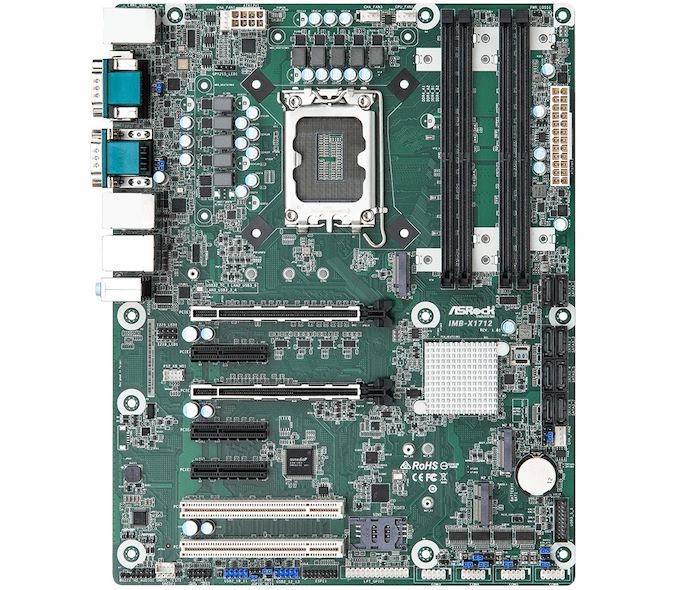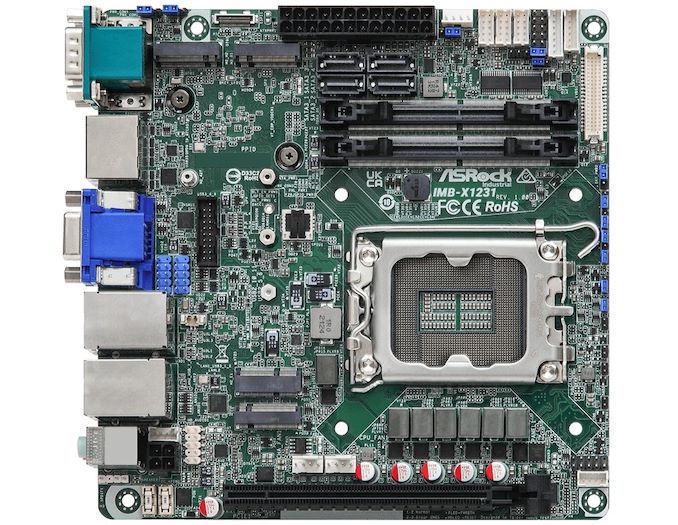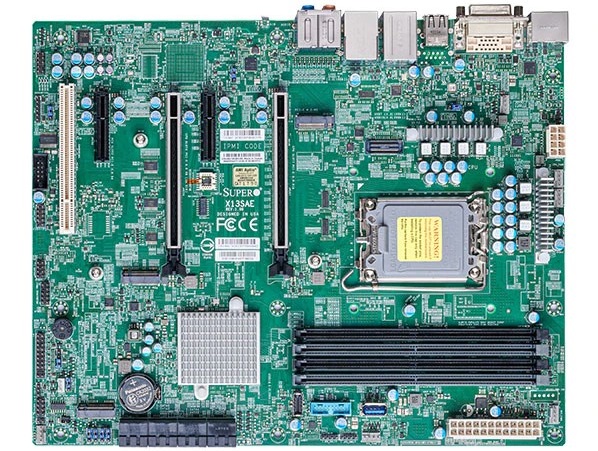The Intel W680 Chipset Overview: Alder Lake Workstations Get ECC Memory and Overclocking Support
by Gavin Bonshor on March 9, 2022 4:00 PM EST_678x452.jpg)
Earlier this month Intel quietly launched its W680 chipset, the company's workstation-focused chipset for its 12th Gen Core (Alder Lake) processors. Unlike the current generation of consumer desktop chipsets such as Z690, H670, B660, and H610, the W680 adds the capability to use ECC DRAM, including both DDR5 and DDR4 variants. At present, there haven't been many W680 motherboard announcements, although a couple of vendors, including ASRock Industrial and Supermicro have a few options listed. So we're giving you the lowdown on W680, what it has to offer, and what technologies it brings for users looking to build a workstation-class desktop with Intel's latest Alder Lake architecture.
The Intel W680 Chipset: Enabling Alder Lake Workstations
Typically when Intel launches a new series of processors for the desktop market, it releases multiple chipsets with varying levels of features. For its 12th Gen Core family, Intel initially launched its CPUs and premium Z690 chipset, and followed that up with its more affordable H660, B660, and H610 chipsets. In most generations the product stack is rounded out a bit later with a W-series workstation-focused chipset, and finally a variety of Xeon-E series.
Enter the Intel W680 chipset, which is Intel's designated workstation chipset for its 12th Gen Core platform. The Intel W680 chipset is interesting for a variety of reasons, not the least of which is that that it formally opens up ECC memory support for Intel's Alder Lake-S desktop processors.

Intel W680 Chipset Block Diagram
Some of the main features of the W680 chipset include a PCIe 4.0 x8 DMI link, which connects the processor to the chipset for improved bandwidth over Intel's previous W-series chipsets. Other features include support for up to eight SATA ports and integrated Wi-Fi 6E PHY/2.5 GbE MACs for vendors to hook in the latest networking controllers. Intel includes support for 16x PCIe 5.0 lanes from the CPU, with the usual 16/0 or 8/8 bifurcation options.
| Intel W680, Z690, W580, and W480 Chipset Comparison | ||||
| Feature | W680 | Z690 | W580 | W480 |
| Socket | LGA1700 | LGA1700 | LGA1200 | LGA1200 |
| uArch | Alder Lake | Alder Lake | Rocket Lake | Comet Lake |
| PCIe Lanes (CPU) | 16 x 5.0 4 x 4.0 |
16 x 5.0 4 x 4.0 |
20 x 4.0 | 16 x 3.0 |
| PCIe Lanes (Chipset) | 12 x 4.0 16 x 3.0 |
12 x 4.0 16 x 3.0 |
24 x 3.0 | 24 x 3.0 |
| PCIe Specification (CPU) | 5.0/4.0 | 5.0/4.0 | 3.0 | 3.0 |
| Memory Support | DDR5-4800B DDR4-3200 |
DDR5-4800B DDR4-3200 |
DDR4-2933 | DDR4-2933 |
| ECC Memory | Y | N | Y | Y |
| DMI Lanes | x8 4.0 | x8 4.0 | N/A | N/A |
| Max USB 3.2 (Gen2/Gen1) | 10/10 | 10/10 | 6/10 | 6/10 |
| USB 3.2 Gen 2x2 (20 Gbps) | Y | Y | ASMedia | ASMedia |
| Total USB | 14 | 14 | 14 | 14 |
| Max SATA Ports | 8 | 8 | 8 | 8 |
| Memory Channels (Dual) | 2/2 | 2/2 | 2/2 | 2/2 |
| Intel Optane Memory Support | Y | Y | Y | Y |
| Intel Rapid Storage Tech (RST) | Y | Y | Y | Y |
| Integrated Wi-Fi MAC | Wi-Fi 6E | Wi-Fi 6E | Wi-Fi 6 | Wi-Fi 6 |
| Intel Smart Sound | Y | Y | Y | Y |
| Overclocking Support | Y | Y | N | N |
| Intel vPro | Y | N | Y | Y |
| ME Firmware | 16 | 16 | 15 | 14 |
| TDP (W) | 6 | 6 | 6 | 6 |
Other features with W680 include native support for USB 3.2 Gen2x2 (20 Gbps) Type-C connectivity. However, most of the cost and implementation of networking and connectivity still rely on vendors using solutions through proprietary CNVi connections. This is much the same story on regular Z690, H670, B660, and H610 options, the cost for the target market is a massive factor here on what vendors decide to include or omit. The point is the capability is there should a vendor wish to utilize it.
Intel W680: Now with Official Overclocking Support for CPU & Memory
On the whole, there isn't much difference between the W680 and Z690 chipsets when comparing technical specifications. This includes package size (both are 28 x 25 mm), USB, PCIe, and storage support, but interestingly there's a new addition to Intel's latest desktop workstation chipset. This 'new' inclusion is official support for overclocking, which is something both of the previous W-series chipsets – W580 and W480 – omitted.
While the last couple of W-series chipsets allowed users to overclock the memory on supported processors, Intel has opened this up to unlocking the core frequency when combined with its K-series processors on W680. And while this functionality is appreciated, it's admittedly unlikely users will want to significantly overclock an already hot running and high-powered Alder Lake processor, especially on a motherboard that doesn't have a robust power delivery system like Z690 motherboards do.
The point to this is Intel is giving users a choice, and while it sounds nonsensical in practice, it's a pretty big move for conservative Intel. It should be noted that its H610 chipset doesn't support CPU overclocking; it's an interesting shift from Intel's previous standpoint when it comes to overclocking.
W680 Motherboards: What's Currently Announced (As of March 9th)
Despite Intel opting for a slow ramp up for its W680 chipset, a few motherboard options are officially listed, including from ASRock Industrial and Supermicro. As time goes by, and perhaps when Intel pulls the trigger on its obligatory Xeon E-3300 family of processors, motherboard vendors might opt to officially announce more models.
The key element with W680 is that while they offer support for existing Alder Lake-S processors, they are designed around its Xeon series, which aren't usually overclockable. These models generally feature lower core frequencies and TDPs, given their greater focus on reliability versus performance.
ASRock Industrial W680
As it stands, ASRock Industrial has four W680 motherboards listed at the time of writing. This includes one thin-ITX model (IMB-X1233-WV), one mini-ITX model (IMB-X1231), one micro-ATX model (IMB-X1314) and one full-sized ATX model (IMB-X1712).

The ASRock Industrial IMB-X1712 ATX (W680) motherboard.
All of ASRock Industrial's W680 options include support for ECC DDR4-3200 memory and offer varying levels of PCIe 4.0 and storage support. The PCIe 4.0 support depends on the form factor as the ITX sized offerings are limited to just one full-length PCIe 4.0 slot, while the IMB-X1314 and IMB-X1712 have two full-length PCIe 4.0 slots available. For the ITX sized models, both benefit from dual 2.5 GbE, while the larger models have three 2.5 GbE controllers, all of which use Intel I225-LM controllers to power each Ethernet port across all models. It's worth noting that the IMB-X1712 includes two PCI slots for legacy devices.

The ASRock Industrial IMB-X1231 mini-ITX (W680) motherboard.
Both the IMB-X1233-WV and IMB-X1231 ITX sized offerings allow support for Alder Lake-S processors with a maximum TDP of 65 W, while the micro-ATX IMB-X1314 and ATX IMB-X1712 enable users to use processors with a base TDP of up to 125 W. Support and compatibility here are aligned and determined by the base frequency TDP rating on these models.
At the time of writing, ASRock Industrial hasn't announced any availability or pricing for any of its W680 models.
Supermicro W680
For Intel's W680 chipset launch, Supermicro has listed two motherboards designed around the new chipset. This includes the X13SAE and the X13SAE-F motherboards. These models are ATX in size and include support for DDR5-4400 memory, both ECC and non-ECC DRAM types.

The Supermicro X13SAE ATX (W680) motherboard.
Despite both the Supermicro X13SAE and X13SAE-F featuring the same base specifications, including dual Ethernet, one powered by an Intel I225-V 2.5 GbE and the other by an Intel I1219-LM Gigabit controller pairing, there is one key difference. The Supermicro X13SAE-F includes IPMI functionality which is powered by an ASPeed AST2600 BMC controller and includes a supplementary Realtek RTL8211F management LAN port.
Both of the Supermicro X13 (W680) allow users to use Alder Lake-S processors with a base TDP of 125 W, and both are using a Realtek ALC888S HD audio codec. They share the same connectivity options, including HDMI 2.1, DisplayPort 1.4, and DVI video outputs, as well as three USB 3.2 G2 Type-A and one USB 3.2 G1 Type-A port on the rear panel.
At the time of writing, Supermicro hasn't shared any information regarding the availability or pricing on its X13 (W680) motherboards.
For other LGA1700 options such as Z690 motherboards, below we have a list of our detailed Intel Alder Lake coverage:
- The Intel 12th Gen Core i9-12900K Review: Hybrid Performance Brings Hybrid Complexity
- The Intel Core i3-12300 Review: Quad-Core Alder Lake Shines
- Intel Architecture Day 2021: Alder Lake, Golden Cove, and Gracemont Detailed
- Intel Announces 12th Gen Core Alder Lake: 22 New Desktop-S CPUs, 8 New Laptop-H CPUs
- The Intel Z690 Motherboard Overview (DDR5): Over 50+ New Models
- The Intel Z690 Motherboard Overview (DDR4): Over 30+ New Models










79 Comments
View All Comments
shadowx360 - Monday, May 2, 2022 - link
Not exactly rare considering all their prior workstation E3s also required UDIMM ECC which you can easily source on Newegg or even eBay.The Von Matrices - Thursday, March 10, 2022 - link
The "workstation" Xeon E/W/E3 have never supported registered memory. Which is a shame because unbuffered ECC DIMMs always seem to be more expensive than registered ECC DIMMs for a given capacity despite having fewer chips.mode_13h - Thursday, March 10, 2022 - link
RDIMMs traditionally have the downside of slightly higher latency. And you only really need it for reaching higher capacities, although it should also alleviate some of the tradeoffs between rank/occupancy vs. speed that are quite notable in Alder Lake.BTW, I think AMD's Opterons *only* supported RDIMMs. I could be wrong on this, but I'm pretty sure most Xeon server boards only support RDIMMs, while the Xeon W's probably support both.
drajitshnew - Friday, March 11, 2022 - link
RDIMMs do not have higher latencies. What does happen is that workstation memory has much poorer timings. For example the best I could find on newegg is DDR4-3200 @ CL22.mode_13h - Friday, March 11, 2022 - link
> RDIMMs do not have higher latencies.At a fundamental level, it doesn't have the same potential for latencies as low as unbuffered. That's due to the extra register/buffer that sits in between the DIMM's interface and the actual DRAM chips. The main reason for this is to reduce the electrical load on the CPU's memory controller, enabling it to drive more DIMMs per channel and at higher speeds.
drajitshnew - Saturday, March 12, 2022 - link
Yes, but with RDIMM you can set the command rate to T1 from T2 which actually makes up for the command buffer latency for dual ranked modules.Silver5urfer - Thursday, March 10, 2022 - link
This sort of segmentation kills Market exposure. Too bad really, the greed overtakes everything. They could simply offer Z series chipset with ECC features and Workstation class boards and OEMs could make them, but nope. We need to milk.Absolute trash move from these bean counters making these decisions with this the people who buy will be low and so less talk around them. And people still will opt for used Xeon systems and Rack servers for Homeserver hobby projects.
Intel did this on X299 with VROC garbage. I just hope Threadripper gets some traction again since AMD is supposedly announcing the 5000 series Genesis Peak TR series soon.
mode_13h - Thursday, March 10, 2022 - link
> This sort of segmentation kills Market exposure.Um, did you know this is *less* segmentation than they usually do? It hasn't been since LGA 775 that Intel supported ECC on its whole line of mainstream CPUs! And the fact that they don't make you choose between it and overclocking is bonus.
Even if you buy Ryzen, not all motherboards will support ECC and their non-Pro APUs don't support it on *any* motherboard. Oh, and you can't buy their Pro APUs unless you're a big OEM.
So, Intel is not a lot less segmented on this front than AMD.
> They could simply offer Z series chipset with ECC features
Even if they did, not all Z-series boards would choose to implement ECC support, because it requires additional traces on the motherboard and additional validation effort by the motherboard vendor.
> Absolute trash move from these bean counters
You're splitting hairs. Damn, some people are near impossible to please.
> people still will opt for used Xeon systems and Rack servers for Homeserver hobby projects.
Well... there's no Alder Lake Xeon E, as far as we know. That means you have to go back to using Ice Lake, which is LGA4189, far more expensive, and far lower single-thread perf. Not very homelab or hobbyist-friendly.
> I just hope Threadripper gets some traction again
Threadripper is in a completely different price segment. It's meant to go up against Xeon W, not this. *This* move is so Intel can better compete with people currently putting AM4 Ryzen 5000 CPUs in workstation boards that support ECC.
mode_13h - Thursday, March 10, 2022 - link
> So, Intel is not a lot less segmented on this front than AMD.Er, I meant they are "now a lot less segmented on this front than AMD."
Silver5urfer - Friday, March 11, 2022 - link
Some of your points are valid but Xeon part, Ice Lake as you said is not good or homelab is false. Ever seen builds of those machines even on the r/homelab ? None of them run the latest Xeons. Because latest ones are far too expensive, which is why I mention "used Xeon systems". And everything is not just ST performance. It's about PCIe too which is why the used Xeon is mentioned.As for Motherboard validation, I clearly mentioned they can create a new lineup along the Z line or a bracket above it, to give the Enterprise feature set. These boards will not be used in much quantities due to far lower spread among the homeservers/homelabs that's my guess.
Personally, I still would wait for next gen socket. Because DDR5 is too niche and worthless right now, even if you buy $500+ top G.Skill Samsung / SKH kit and if you use DDR4 Z690 like Strix D4, the DRAM and IMC performance is not that great. And also the LGA1700 ILM design flaw. I need a homelab today, I would go and get a used Xeon.